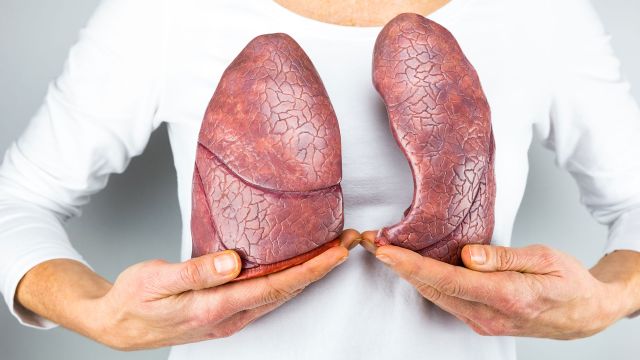Lung cancer is cancer that begins in the lungs, the organs in your chest that help your body take in oxygen and expel carbon dioxide. Your lungs are made up of sponge-like lobes. The right lung has three lobes; the left lung has two. When you breathe, air travels through your nose, down your windpipe (trachea) and into your lungs, where it spreads to the air sacs through tubes called bronchi. Cancer can form in any of these tissues.
Most lung cancers are carcinomas, cancers that form in tissues made of epithelial cells. Epithelial cells cover the skin and form the inner lining of the body’s internal structures, including the lungs. Carcinomas are the most common type of cancer.
There are two main types of lung cancer—non-small cell lung carcinomas (NSCLC) and small cell lung carcinomas (SCLC). Non-small cell lung carcinomas are the most common type, accounting for 80 to 85 percent of lung cancers. Small cell lung carcinomas account for 10 to 15 percent of lung cancers.
The cells of non-small lung carcinomas appear larger when viewed with a microscope, while the cells of small cell lung carcinomas appear smaller. However, there are numerous differences between these two types of cancer beyond the size of the cells.
Non-small cell lung cancers
Non-small cell lung carcinomas generally grow and spread more slowly than small cell lung carcinomas. There are three common types:
- Adenocarcinoma. This type accounts for about 40 percent of all cases of lung cancer, making it the most common form of the disease. It usually begins in an outer area of the lung, in cells that normally secrete mucus or other substances.
- Squamous cell carcinomas. This type of non-small cell lung cancer begins in the squamous cells, flat cells that form the inner lining of the lungs and airways. This type accounts for 25 to 30 percent of all cases of lung cancer.
- Large cell carcinomas. This type accounts for 10 to 15 percent of lung cancers. It can occur in any part of the lung and tends to grow and spread more aggressively than the other two types.
Though all three fall under the category of non-small cell lung carcinoma, each type is different, and there are different treatments for each.
Small cell lung cancer
There are two types of small cell lung carcinoma: small cell carcinoma and combined small cell carcinoma. Small cell carcinomas are sometimes called oat cell carcinoma because the cancer cells look similar to oat grains when viewed with a microscope (in addition to the lungs, small cell cancers can originate in other parts of the body, such as the bladder and prostate). Combined small cell lung carcinoma, or cSCLC, is small cell lung carcinoma that contains components of non-small cell lung carcinoma, and is rare.
Small cell lung carcinomas grow quickly and metastasize aggressively, forming large tumors that spread to other areas of the body such as the bones, brain, lymph nodes, adrenal glands and liver. Sometimes the affected areas appear as tumors on x-rays and other imaging tests, but early on, these cancers may be difficult to detect. In most patients, this type of cancer has metastasized by the time they are diagnosed.





